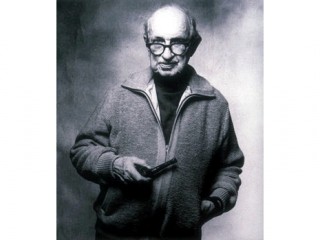
Morley Callaghan biography
Date of birth : 1903-02-22
Date of death : 1990-08-25
Birthplace : Toronto, Canada
Nationality : Canadian
Category : Famous Figures
Last modified : 2011-03-14
Credited as : Novelist, short-story writer, Close to the Sun Again, Molson Prize
The Canadian novelist and short-story writer Edward Morley Callaghan was one of the major figures of 20th-century Canadian fiction. His work was linked with the development in American writing symptomatic of the 1920s.
Morley Callaghan was born on February 22, 1903, in Toronto into an Irish Roman Catholic family. He graduated from the University of Toronto in 1925. During his college years Callaghan held a summer job as a reporter with the Toronto Daily Star, where he met Ernest Hemingway. The two exchanged stories, and Hemingway encouraged Callaghan in his writing. In 1925 Callaghan enrolled in law school at Osgoode Hall in Toronto and was admitted to the Ontario bar in 1928.
Callaghan's career as a writer began in 1921, when he sold a descriptive piece to the Toronto Star Weekly. In 1926 he published his first short story in the Paris magazine This Quarter, had another accepted by transition, and started on his first novel, Strange Fugitive. At this time Callaghan visited New York, and his friendships from this and subsequent visits included William Carlos Williams, Allen Tate, Ford Madox Ford, Katherine Ann Porter, and Sinclair Lewis.
Callaghan also attracted the attention of Maxwell Perkins of Scribner's, and his stories began to appear regularly in American and European magazines. In 1928 Scribner's published Strange Fugitive and in 1929 a collection of short stories, A Native Argosy. Callaghan married Loretto Dee in 1929 and went to Paris for eight months. He completed a novel, It's Never Over (1929), and a novella, No Man's Meat (1931).
The 1930s were an active and prolific period for Callaghan. He published four novels: A Broken Journey (1932), Such Is My Beloved (1934), They Shall Inherit the Earth (1935), and More Joy in Heaven (1937). He produced a second collection of stories, Now That April's Here and Other Stories (1936), and wrote two plays in 1939, Turn Again Home and Just Ask for George.
Callaghan's work of this period was strongly affected by the experiences of the Depression. But partly owing to the influence of the French philosopher Jacques Maritain, whom Callaghan knew in Toronto in 1933, it began to show a strain of Christian humanism and a strong sense of personal virtue coupled with deinstitutionalized Christian values. Father Dowling, the idealistic and naive Catholic priest who is the hero of Such Is My Beloved, is a good example.
During World War II Callaghan was attached to the Royal Canadian Navy and served on assignment for the National Film Board of Canada. He also became a well-known radio figure.
In 1948 Callaghan returned to writing with a fictionalized account of life at the University of Toronto, The Varsity Show, and a juvenile novel, Luke Baldwin's Vow. But it was not until 1951 and the publication of the Governor General's Award—winning novel, The Loved and the Lost, that Callaghan truly restaked his claim in the field of Canadian fiction.
In 1959 Morley Callaghan's Stories, a book comprising his best short fiction, appeared. Two novels followed, The Many Coloured Coat (1960) and A Passion in Rome (1961). That Summer in Paris (1963), an autobiographical reminiscence, deals with Callaghan's eight-month stay in Paris in 1929. It tells something of the novelist's relationship with the Paris expatriates and the complicated friendships of the leading writers of that day, prominent among whom were Hemingway and James Joyce. Callaghan also reveals his own ideas about writing and the writer's craft. This stage in Callaghan's artistic development showed a more refined, if sharper and more tragic, sense of moral responsibility presented in prose of richer texture and occasional symbolic overtones.
In 1967 Callaghan was named in the first Order of Canada honors list. In 1970 he won the Molson Prize and the valuable and prestigious Royal Bank of Canada Award for his contribution to the artistic and intellectual life of Canada.
While Callaghan's short stories continued to garner praise, his later novels met with mixed reviews. Ambitious ideas were often marred by clumsy plotting, stilted dialogue, and cliched characterizations. In A Fine and Private Place (1975), Callaghan adopted the persona of a bitter novelist, Eugene Shore, to attack critics who refused to take him seriously as a writer. His next novel Close to the Sun Again (1977) shed the caustic veneer for a return to the humanistic themes of his earlier work. The novel relates the last days of Ira Groome, a widowed chairman of a municipal commission who comes to lament the loss of passion and joy in his life. Sitting in his hospital bed after a serious car accident, Groome drifts away into his wartime memories, recalling a time when sacrifice and suffering made his existence worthwhile. After experiencing a moment of epiphany, he dies.
The unsuccessful works A Time for Judas (1983) and Our Lady of the Snows (1985) did little to enhance Callaghan's reputation, or his bankbook. But he did have one last good novel in him, the vigorous swan song A Wild Old Man on the Road (1988). Set in Paris and Toronto, the novel returns to familiar Callaghan terrain in more ways than one. The story of an idealistic young Canadian writer who befriends—and grows steadily disillusioned by—his hero, a left-leaning British journalist turned neo-conservative, the novel brims with compassion and moral inquiry, the very stuff that had made Callaghan such a vital artist for so many years.
A longtime Toronto resident, Callaghan remained doggedly independent until the end of his life. He broke a hip in 1989 at the age of 88, but still persisted in walking to his neighborhood grocery store to do his shopping. He died of natural causes in Toronto on August 25, 1990.
















